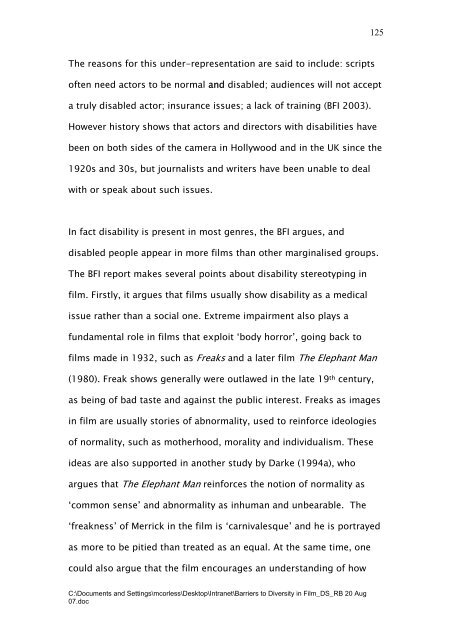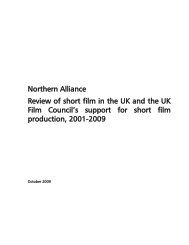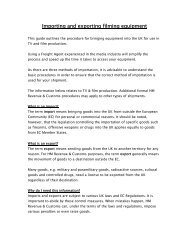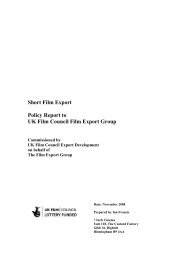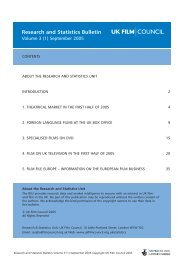Barriers to Diversity in Film – A Research Review – Aug 07
Barriers to Diversity in Film – A Research Review – Aug 07
Barriers to Diversity in Film – A Research Review – Aug 07
Create successful ePaper yourself
Turn your PDF publications into a flip-book with our unique Google optimized e-Paper software.
The reasons for this under-representation are said <strong>to</strong> <strong>in</strong>clude: scripts<br />
often need ac<strong>to</strong>rs <strong>to</strong> be normal and disabled; audiences will not accept<br />
a truly disabled ac<strong>to</strong>r; <strong>in</strong>surance issues; a lack of tra<strong>in</strong><strong>in</strong>g (BFI 2003).<br />
However his<strong>to</strong>ry shows that ac<strong>to</strong>rs and direc<strong>to</strong>rs with disabilities have<br />
been on both sides of the camera <strong>in</strong> Hollywood and <strong>in</strong> the UK s<strong>in</strong>ce the<br />
1920s and 30s, but journalists and writers have been unable <strong>to</strong> deal<br />
with or speak about such issues.<br />
In fact disability is present <strong>in</strong> most genres, the BFI argues, and<br />
disabled people appear <strong>in</strong> more films than other marg<strong>in</strong>alised groups.<br />
The BFI report makes several po<strong>in</strong>ts about disability stereotyp<strong>in</strong>g <strong>in</strong><br />
film. Firstly, it argues that films usually show disability as a medical<br />
issue rather than a social one. Extreme impairment also plays a<br />
fundamental role <strong>in</strong> films that exploit ‘body horror’, go<strong>in</strong>g back <strong>to</strong><br />
films made <strong>in</strong> 1932, such as Freaks and a later film The Elephant Man<br />
(1980). Freak shows generally were outlawed <strong>in</strong> the late 19 th century,<br />
as be<strong>in</strong>g of bad taste and aga<strong>in</strong>st the public <strong>in</strong>terest. Freaks as images<br />
<strong>in</strong> film are usually s<strong>to</strong>ries of abnormality, used <strong>to</strong> re<strong>in</strong>force ideologies<br />
of normality, such as motherhood, morality and <strong>in</strong>dividualism. These<br />
ideas are also supported <strong>in</strong> another study by Darke (1994a), who<br />
argues that The Elephant Man re<strong>in</strong>forces the notion of normality as<br />
‘common sense’ and abnormality as <strong>in</strong>human and unbearable. The<br />
‘freakness’ of Merrick <strong>in</strong> the film is ‘carnivalesque’ and he is portrayed<br />
as more <strong>to</strong> be pitied than treated as an equal. At the same time, one<br />
could also argue that the film encourages an understand<strong>in</strong>g of how<br />
C:\Documents and Sett<strong>in</strong>gs\mcorless\Desk<strong>to</strong>p\Intranet\<strong>Barriers</strong> <strong>to</strong> <strong>Diversity</strong> <strong>in</strong> <strong>Film</strong>_DS_RB 20 <strong>Aug</strong><br />
<strong>07</strong>.doc<br />
125


